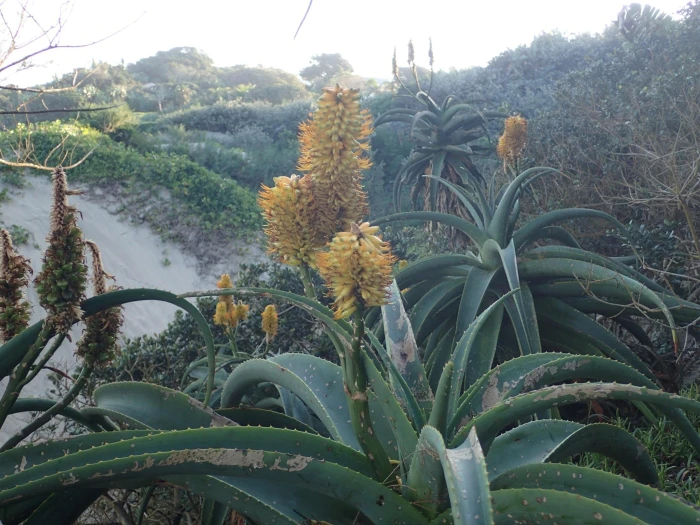Dune Aloe
(Aloe thraskii)
Dune Aloe (Aloe thraskii)
/
/

Peter Warren
Public Domain
Image By:
Peter Warren
Recorded By:
Copyright:
Public Domain
Copyright Notice:
Photo by: Peter Warren | License Type: Public Domain | License URL: http://creativecommons.org/publicdomain/zero/1.0/ | Rights Holder: Peter Warren | Publisher: iNaturalist | Date Created: 42562 |














Estimated Native Range
Climate Requirements for Brookfield, Wisconsin
| This Plant | Your Site | Plant Suitability for Your Location | ||
|---|---|---|---|---|
| • Precipitation | 23" - 43" | 32" | Your precipitation may be insufficient for this plant. Irrigate N" / year. | Irrigate N" / year |
| • High Temp. | 77°F - 85°F | 82°F | Your summer temperatures are normal for this plant. | Excellent |
| • Low Temp. | 48°F - 55°F | 10°F | Your winter temperatures may be too cold for this plant | Too cold |
This plant should grow well at your location with about N inches per year (Y minutes per month) of irrigation.
Summary
Aloe thraskii, commonly known as Dune Aloe, is an evergreen succulent native to coastal dunes and sandy habitats in Southeastern South Africa, particularly in the Eastern Cape to KwaZulu-Natal. It can reach a height of 6-10 feet (1.8-3 meters) and a width of 3-10 feet (0.9-3 meters). The Dune Aloe is characterized by its tall, unbranched form with a large rosette of long, pale, grey-green leaves that are deeply grooved or channeled, giving them a U-shaped cross-section, and recurve downwards. It produces showy orange flowers in the spring and winter, which grow in short, compact, cylindrical racemes on multi-branched inflorescences, attracting pollinators such as birds and bees.
This plant is valued for its architectural form and the striking contrast its foliage and flowers provide in xeriscaped gardens, rockeries, and coastal landscapes. It is also used as an accent or specimen plant in succulent collections. Dune Aloe is drought-tolerant, requiring very low to low amounts of water, and thrives in well-draining soils. It prefers full sun but can tolerate some light shade. While generally disease-resistant, it can be susceptible to root rot if overwatered or planted in poorly draining soils. It is not known to have aggressive roots or significant disease problems, but it should be protected from frost to prevent damage to the leaves.CC BY-SA 4.0
This plant is valued for its architectural form and the striking contrast its foliage and flowers provide in xeriscaped gardens, rockeries, and coastal landscapes. It is also used as an accent or specimen plant in succulent collections. Dune Aloe is drought-tolerant, requiring very low to low amounts of water, and thrives in well-draining soils. It prefers full sun but can tolerate some light shade. While generally disease-resistant, it can be susceptible to root rot if overwatered or planted in poorly draining soils. It is not known to have aggressive roots or significant disease problems, but it should be protected from frost to prevent damage to the leaves.CC BY-SA 4.0
Plant Description
- Plant Type: Succulent
- Height: 6-10 feet
- Width: 3-10 feet
- Growth Rate: Moderate
- Flower Color: Orange, Yellow
- Flowering Season: Spring, Winter
- Leaf Retention: Evergreen
Growth Requirements
- Sun: Full Sun
- Water: Very Low, Low
- Drainage: Fast
Common Uses
Bee Garden, Bird Garden, Drought Tolerant, Fire Resistant, Hummingbird Garden, Low Maintenance, Rabbit Resistant, Salt Tolerant, Showy Flowers
Natural Habitat
Coastal dunes and sandy habitats
Other Names
Common Names: Coast Aloe, Strand Aloe
Scientific Names: Aloe thraskii, Aloe fraskii
GBIF Accepted Name: Aloe thraskii Baker